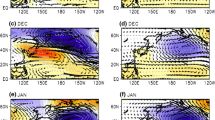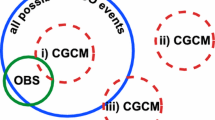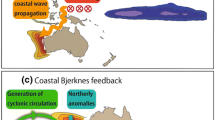Abstract
Teleconnections associated with warm El Niño/southern oscillation (ENSO) events in 20 climate model intercomparison project 5 (CMIP5) models have been compared with reanalysis observations. Focus has been placed on compact time and space indices, which can be assigned a specific statistical confidence. Nearly all of the models have surface temperature, precipitation and 250 hPa geopotential height departures in the Tropics that are in good agreement with the observations. Most of the models also have realistic anomalies of Northern Hemisphere near-surface temperature, precipitation and 500 hPa geopotential height. Model skill for these variables is significantly related to the ability of a model to accurately simulate Tropical 250 hPa height departures. Additionally, most models have realistic temperature and precipitation anomalies over North America, which are linked to a model’s ability to simulate Tropical 250 hPa and Northern Hemisphere 500 hPa height departures. The skills of temperature and precipitation departures over the Northern Hemisphere and North America are associated with the ability to realistically simulate realistic ENSO frequency and length. Neither horizontal nor vertical resolution differences for either the model atmosphere or ocean are significantly related at the 95 % level to variations in El Niño simulation quality. Overall, recent versions of earlier models have improved in their ability to simulate El Niño teleconnections. For instance, the average model skills of temperature and precipitation for the Tropics, Northern Hemisphere and North America for 11 CMIP5 models are all larger than those for prior versions.











Similar content being viewed by others
References
AchutaRao K, Sperber KR (2006) ENSO simulation in coupled ocean-atmosphere models: are the current models better? Clim Dyn 27:1–15
Ashok K, Yamagata T (2009) The El Niño with a difference. Nature 461:481–484
Collins WD et al (2006) The community climate system model version 3 (CCSM3). J Clim 19:2122–2143
Collins WJ, Bellouin N, Doutriaux-Boucher M, Gedney N, Hinton T, Jones CD, Liddicoat S, Martin G, O’Connor F, Rae J, Senior C, Totterdell I, Woodward S (2008) Evaluation of the HadGEM2 model. Meteorological Office Hadley Centre, technical note 74. http://www.metoffice.gov.uk/publications/HCTN/HCTN_74.pdf
Collins M et al (2010) The impact of global warming on the tropical Pacific Ocean and El Nino. Nat Geosci 3:391–397. doi:10.1038/NGEO868
Dee DP, Uppala SM, Simmons AJ et al (2011) The ERA-interim reanalysis: configuration and performance of the data assimilation system. Q J Roy Meteorol Soc 137:553–597
Diansky NA, Volodin EM (2002) Simulation of present-day climate with a coupled atmosphere-ocean general circulation model, Izvestiya. Atmos Ocean Phys 38:732–747
Douville H, Chauvin F, Planton S, Royer J-F, Salas-Me’lia D, Tyteca S (2002) Sensitivity of the hydrological cycle to increasing amounts of greenhouse gases and aerosols. Clim Dyn 20:45–68. doi:10.1007/s00382-002-0259-3
Dufresne J-L et al (2012) Climate change projections using the IPSL–CM5 earth system model: from CMIP3 to CMIP5 Clim Dyn (in revision). http://www.lmd.jussieu.fr/~jldufres/publi_ipslcm5/Smi/ipsl-cm5.pdf
Gent PR, Danabasoglu G, Donner LJ, Holland MM, Hunke EC, Jayne SR, Lawrence DM, Neale RB, Rasch PJ, Vertenstein M, Worley PH, Yang Z-L, Zhang M (2011) The community climate system model version 4. J Clim 24:4973–4991
Giorgetta MA, Roeckner E, Mauritsen T, Stevens B, Crueger T, Esch M, Rast S, Kornblueh L, Schmidt H, Kinne S, Möbis B, Krismer T, Reick C, Raddatz T, Gayler V (2012) The atmospheric general circulation model ECHAM6—model description. http://www.mpimet.mpg.de/en/science/models/echam.html
Glantz MH (2001) Currents of change. Cambridge University Press, Cambridge, p 252
Gordon C, Cooper C, Senior CA, Banks HT, Gregory JM, Johns TC, Mitchell JFB, Wood RA (2000) The simulation of SST, sea ice extents and ocean heat transports in a version of the Hadley Centre coupled model without flux adjustments. Clim Dyn 16:147–168
Guilyardi E (2006) El Niño-mean state-seasonal cycle interactions in a multi-model ensemble. Clim Dyn 26:329–348
Guilyardi E, Gualdi S, Slingo J, Navarra A, Delecluse P, Cole J, Madec G, Roberts M, Latif M, Terray L (2004) Representing El Niño in coupled ocean–atmosphere GCMs: the dominant role of the atmospheric component. J Clim 17:4623–4629
Guilyardi E, Cai W, Collins M, Fedorov A, Jin F-F, Kumar A, Sun D-Z, Wittenberg A (2012) New strategies for evaluating ENSO processes in climate models. Bull Am Meteorol Soc 93:235–238
Hoskins BJ, Karoly DJ (1980) The steady linear response of a spherical atmosphere to thermal and orographic forcing. J Atmos Sci 38:1179–1196
Johns TC et al (2006) The new Hadley centre climate model (HadGEM1): evaluation of coupled simulations. J Clim 19:1327–1353
Kanamitsu M, Ebisuzaki W, Woollen J, Yang S-K, Hnilo JJ, Fiorino M, Potter GL (2002) NCEP–DOE AMIP-II reanalysis (R-2). Bull Am Meteorol Soc 83:1631–1643
Latif M, Keenlyside NS (2009) El Nino/southern oscillation response to global warming. Proc Natl Acad Sci USA 106:20578–20583
Latif M, Anderson D, Barnett T, Cane M, Kleeman R, Leetmaa A, O’Brien J, Rosati A, Schneider E (1998) A review of the predictability and prediction of ENSO. J Geophys Res 103:14375–14393
Leloup J, Lengaigne M, Boulanger J-P (2008) Twentieth century ENSO characteristics in the IPCC database. Clim Dyn 30:277–291
Marti O et al (2010) Key features of the IPSL ocean atmosphere model and its sensitivity to atmospheric resolution. Clim Dyn 34:1–26
Meehl GA, Teng H (2007) Multi-model changes in El Niño teleconnections over North America in a future warmer climate. Clim Dyn 29:779–790
Meehl GA, Covey C, Delworth T, Latif M, McAvaney B, Mitchell JFB, Stouffer RJ, Taylor KE (2007) The WCRP CMIP3 multimodel dataset: a new era in climate change research. Bull Am Meteorol Soc 88:1349–1383
Mochizuki T et al (2010) Pacific decadal oscillation hindcasts relevant to near-term climate prediction. Proc Natl Acad Sci USA 107:1833–1837
Mochizuki T, Chikamoto Y, Mimoto M, Ishii M, Tatebe H, Komuro Y, Sakamoto TT, Watanabe M, Mori M (2012) Decadal prediction using a recent Series of MIROC global climate models. J Meteorol Soc Jpn 90A:373–383
Neelin JD (2011) Climate change and climate modeling. Cambridge University Press, Cambridge, p 282
Neelin JD, Battisti DS, Hirst AC, Jin FF, Wakata Y, Yamagata T, Zebiak SE (1998) ENSO theory. J Geophys Res Ocean 103:14261–14290
Philander G (1990) El Niño, La Niña, and the southern oscillation. Academic Press, San Diego, p 289
Roeckner E, Stier P, Feichter J, Kloster S, Esch M, Fischer-Bruns I (2006) Impact of carbonaceous aerosol emissions on regional climate change. Clim Dyn 27:553–571
Sato N, Takahashi C, Seiki A, Yoneyama K, Shirooka R, Takayabu YN (2009) An evaluation of the reproducibility of the Madden–Julian oscillation in the CMIP3 multi-models. J Meteorol Soc Jpn 87:791–805. doi:10.2151/jmsj.87.791
Schmidt GA, Ruedy R, Hansen JE et al (2006) Present day atmospheric simulations using GISS model E: comparison to in situ, satellite and reanalysis data. J Clim 19:153–192
Schneider EK, Fennessy MJ, Kinter JL III (2009) A statistical-dynamical estimate of winter ENSO teleconnections in a future climate. J Clim 22:6624–6638
Seland Ø, Iversen T, Kirkevåg A, Storelvmo T (2008) Aerosol–climate interactions in the CAM–Oslo atmospheric GCM and investigations of associated shortcomings. Tellus 60A:459–491
Taylor KE (2001) Summarizing multiple aspects of model performance in a single diagram. J Geophys Res 106:7183–7192. doi:10.1029/2000JD900719
Trenberth KE (1997) The definition of El Niño. Bull Am Meteorol Soc 78:2771–2777
Uppala SM et al (2005) The ERA-40 re-analysis. Q J R Meteorol Soc 131:2961–3012
Voldoire A, Sanchez-Gomez E, Salas y Mélia D et al (2012) The CNRM–CM5.1 global climate model: description and basic evaluation. doi:10.1007/s00382-011-1259-y
Volodin EM, Diansky NA, Gusev AV (2010) Simulating present-day climate with the INMCM4.0 coupled model of the atmospheric and oceanic general circulations, Izvestia. Atmos Ocean Phys 46:414–431
von Storch H, Zwier FW (1999) Statistical analysis in climate research. Cambridge University Press, Cambridge, p 484
Watanabe S, Hajima T, Sudo K et al (2011) MIROC–ESM 2010: model description and basic results of CMIP5-20c3 m experiments. Eosci Model Dev 4:845–872. doi:10.5194/gmd-4-845-2011
Widmann M, Bretherton CS (2000) Validation of mesoscale precipitation in the NCEP reanalysis using a new gridcell dataset for the Northwestern United States. J Clim 13:1936–1950
Wu T, Yu R, Zhang F et al (2010) The Beijing Climate Center for atmospheric general circulation model (BCC–AGCM2.0.1): description and its performance for the present-day climate. Clim Dyn 34:123–147
Yu YQ, Zheng WP, Wang B, Liu HL, Liu JP (2011) Versions g1.0 and g1.1 of the LASG/IAP flexible global ocean–atmosphere-land system model. Adv Atmos Sci 28:99–117. doi:10.1007/s00376-010-9112-5
Yukimoto S, Endoh M, Kitamura Y, Kitoh A, Motoi T, Noda A (2000) ENSO-like interdecadal variability in the Pacific Ocean as simulated in a coupled general circulation model. J Geophys Res Ocean 105:13945–13963. doi:10.1029/2000JC900034
Zhang Y-L, Yu Y-Q (2011) Analysis of decadal climate variability in the tropical Pacific by coupled GCM. Atmos Ocean Sci Lett 4:204–208
Acknowledgments
This work was partially supported by NSF grant ATM0733698. NCEP/NCAR_Reanalysis 2 data provided by the NOAA/OAR/ESRL PSD, Boulder, CO, USA, from their Web site at http://www.esrl.noaa.gov/psd/. ERA-40 and ERA-Int data were kindly provided by the European Centre for Medium-Range Weather Forecasting. I acknowledge the World Climate Research Programme’s Working Group on Coupled Modelling, which is responsible for CMIP. The US Department of Energy’s Program for Climate Model Diagnosis and Intercomparison provides coordinating support for CMIP and led development of software infrastructure in partnership with the Global Organization for Earth System Science Portals. Finally, I heartily thank the many climate modeling groups for producing and making available their model output.
Author information
Authors and Affiliations
Corresponding author
Rights and permissions
About this article
Cite this article
Weare, B.C. El Niño teleconnections in CMIP5 models. Clim Dyn 41, 2165–2177 (2013). https://doi.org/10.1007/s00382-012-1537-3
Received:
Accepted:
Published:
Issue Date:
DOI: https://doi.org/10.1007/s00382-012-1537-3




